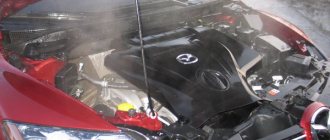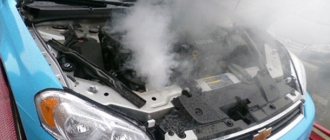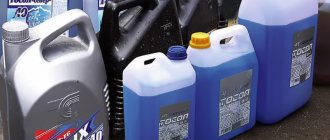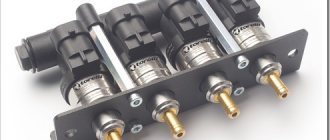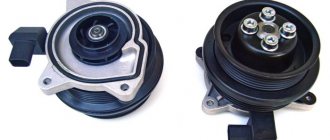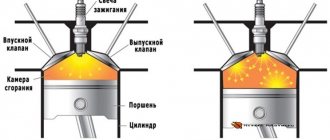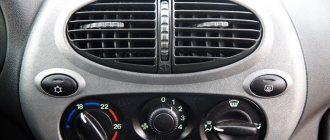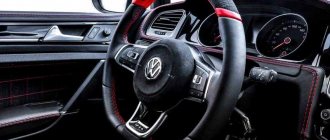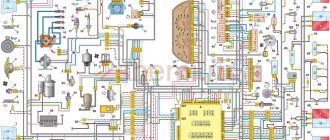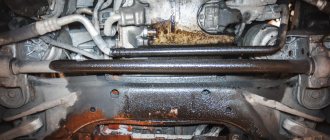How to understand that the engine is overheated
The easiest way is to look at the readings of the coolant temperature sensor. There is a red zone on his scale. If the arrow touches it, expect grief, and if it is already “on red” - “trouble has come - open the gate.”
There are cars in which “prudent” (this is banter) designers made a pointer in the form of a control lamp, which with its “red eye” signals that “we have arrived”, it is necessary to save the engine from overheating. The insidiousness of such minimalism is that the sensor confronts us with a fact, not allowing us to avoid trouble in advance. Thank God, a small part of such cars, in addition to the red one, also have blue (everything is fine) and yellow (be careful!) “controls”, which make it easier to monitor the heating of antifreeze.
But what to do if the car does not have a dashboard at all (there are some), the sensor does not work for some reason, or the driver was doing some other, more important things than looking at the instruments?
Experienced drivers know how to detect overheating - by the sudden sound of detonation in the engine cylinders, by loss of traction, louder operation and deterioration in dynamics, as if a loaded trailer had been quietly hooked up to the car.
Of course, the most direct sign of overheating is clouds of steam escaping from under the hood lid, whistling, hissing and a characteristic smell like a geyser of streams of boiling antifreeze rushing onto the road.
Before we move on to the next chapter, understand and remember the main thing: the temperature of an overheated engine, or more precisely, its coolant, is 120-130 ° C, so stay away from its seething flows and clouds of steam escaping - you can get terrible burns!
How to get to the repair
In some cases, the performance of a car can be restored when it boils. The presence or absence of such a possibility is determined by the type of fault detected.
If the thermostat fails, its housing is opened, the thermoelement is removed and reassembled in the reverse order. After such repairs, you can operate the car indefinitely. However, in the cold season, the engine will not reach operating temperature, which will adversely affect its service life and fuel consumption. In addition, the “heater” will not be able to warm up the interior.
If the temperature sensor fails (the fan does not work), the fan can be started if you remove the chip from the faulty sensor. The unit will begin to rotate and will do this constantly, even after the ignition is turned off. You can’t drive like this for a long time, but getting to the nearest auto repair shop is quite possible.
Air pockets can be removed if, before adding coolant, you remove the pipe suitable for the power system receiver. When the air is removed, antifreeze will flow from the pipe (relevant for VAZ cars). In the same way, antifreeze should be added if it is insufficient.
Sometimes a boiling car can be revived by cleaning the radiator of external contaminants. The part is not washed to remove internal congestion under road conditions.
If there are malfunctions that cannot be eliminated on the road, you should continue driving with the minimum possible load on the engine, with the heater and cooling fan constantly on. The same rule is relevant if it was not possible to establish why the car is heating up and boiling.
In cases where even a light driving mode does not allow maintaining an acceptable temperature, the engine should be turned off and the car should be transported by tow or tow truck.
Causes of engine overheating
The patriarchs of automobile repair many years ago developed the main principle of searching for the causes of engine overheating: “Either somewhere they heat too much, or somewhere they don’t cool enough.”
A car has one source of thermal energy - its engine, or more precisely, its cylinders, where fuel combustion occurs.
Too high a temperature in this area may have the following reasons:
- Substandard fuel;
- Incorrectly functioning power and/or ignition system;
- Misaligned gas distribution mechanism (GRM), for example, due to a belt or chain jumping “by one or two teeth”;
- Increased carbon formation on the piston crown, combustion chamber walls and valves.
Eliminating these causes of antifreeze boiling requires “surgery” and a relatively complex repair. But don’t let this scare you - the listed symptoms make themselves felt long before the question “why the car is boiling” arises. You can fix everything quickly and inexpensively if you visit a good service station with competent technicians in advance, where the engine will be put in order. But if you “let things take their course,” then the boiling of antifreeze for the reasons described above will mean one thing - a very immediate need to find an impressive amount of money to restore the engine.
A short digression about diesel engines
There are minimal reasons for a diesel engine to boil, especially a modern one. This is due to its high efficiency. The overwhelming majority of thermal energy is converted into mechanical energy; heat transfer to the cooling system is small. And so much so that sometimes it is not enough to adequately heat the interior in winter, and the air conditioning system has to be equipped with electric heaters - the coolant has time to cool down before reaching the “stove”. Therefore, the cooling systems of diesel engines with Common Rail (HDi, TDI, CDI, CRDi, JTD, etc.) have a huge margin of resistance to overheating. Nevertheless, troubles with “under-hood geysers” can occur here too.
Let’s leave aside the discussion of the design shortcomings of some diesel engines from companies incompetent in their creation, of which, to everyone’s delight, there are few. Let us focus on the fact that the high reliability and huge advantages of “compression ignition engines” from reputable manufacturers (for example, Peugeot has been producing its excellent quality diesel engines for 100 years!) can easily be crossed out by a sloppy attitude to their maintenance, rednecks and roteness during operation. We are sure that there are no such “riders” among the readers.
Gasoline engines
These units are more widespread than diesel engines, so a few words about them. Modern gasoline engines are more heat-loaded than those produced a couple of decades ago. There is no conspiracy here - these are the requirements of modern trends and the laws of physics, according to which a gasoline engine can provide high efficiency only when operating at an operating temperature above 100°C. Back in the early 2000s, this value fluctuated around “90”, and in our time, laureates of the “Engine of the Year” competition already consider 103°C to be the norm. At the same time, the public demands a reduction in weight and compactness (consequences of the fight for the environment), which is why motors are created with a minimum margin of strength and temperature overload. This is successfully compensated by the increased performance of the cooling systems and the pressure in them, but if the problems we discuss here occur, there will be no time for thinking and erroneous actions - fatal consequences for the life of the engine will occur very quickly.
Insufficient cooling is the main factor in boiling
This is a more common and less fatal cause of overheating than from internal engine problems.
Let us briefly list the main ones:
- Clogging of honeycomb radiators with dust, dirt, poplar fluff and insect corpses;
- Clogging up to complete obstruction of the internal channels of radiators due to the use of low-quality or not intended for this equipment, fully expired and depleted antifreeze, as well as due to “experiments” with their mixing;
- Coolant leakage from loose connections of rubber pipelines, as well as through cracks in their walls formed due to natural aging;
- Thermostats “stuck” in the closed position;
- Burnt-out electric motors and/or cooling fan control relays and their fuses;
- Breaks in the belts of drive units, if they drive the pump (many engines have a pump driven by a timing belt, which is more reliable);
- Destruction of pump blades due to chemical erosion or cavitation, which is often a consequence of the use of low-quality antifreeze;
- Damage to the valves of the expansion tank caps, due to which the pressure is released to the outside, in the system it is close to atmospheric, and the liquid boils at 100°C instead of the required (for example) 130°C;
- Mechanical damage to cooling system elements.
Five important tips you can’t do without when your engine overheats
Heat! Heat! It's hot!!! Summer has arrived in the European part of Russia. Don't believe me? Look at the weather map, for example, on Yandex, and make sure that the heat temperature is rising and is gradually covering the entire territory of the country:
Yes, there is no abnormal heat in Siberia and the Far East yet, but apparently the front of hot air, from which the asphalt seems to be slowly melting, has simply not reached them yet.
Many of us are already planning trips for the next vacation. Some people have been going to their dacha every weekend since mid-spring, and since the first days of May nature lovers have probably been at least a couple of times to barbecue or go fishing/beach vacation/walk through a remote forest, which still needs to be reached (underline as appropriate).
All this wonderful pastime is associated with one unpleasant factor - the need to travel along congested highways, clogged with cars and traffic jams. And guess what? These are ideal conditions for a car engine to overheat. Anyone who has not found themselves in a similar situation will not understand all the panic that grips the driver at the moment when the temperature gauge begins to creep up uncontrollably, you are in a dead traffic jam and have absolutely no idea what to do.
To prevent this from happening to you, we offer you five tips that will help you avoid such a surprise, and we will also tell you what to do if this does happen to you and your car.
And the first thing you will have to do to ensure that your car does not get stuck on the side of the road with an open hood and “boiling” coolant is to prepare your car for the trip.
What to do if the engine has already boiled
1. The first thing you need to do is: when you turn to the side of the road, stop, turn on the emergency lights, and perform the maneuver as safely as possible for yourself and those around you. After stopping, making sure that the car will not accidentally roll anywhere, turn off the engine. We especially draw your attention to turn off the engine (!) , since among car enthusiasts there is an opinion that the engine needs to continue to operate at idle speed. Our experts categorically disagree with this opinion, and we will soon explain why.
2. At least open the hood slightly by pulling the corresponding handle in the cabin. It would be better to open it completely, but don’t risk it! It happens that hot steam and boiling splashes of coolant begin to escape from under the slightly open lid, which can cause burns. It is best, after the “casket has opened slightly,” to approach the car from the front and, from a harmless distance, observe what is happening “in fiery hell.” If nothing threatens, open the engine compartment completely.
3. And then wait, wait, wait, wait for at least 20 minutes! After turning off the ignition - without touching anything on the car. During this time, everything must cool down so that you or other participants in the events can safely carry out any work in the engine compartment.
The mentioned 20 minutes (if more is better) should be enough to:
- Get water, a lot of water, the purest, preferably about 10 liters or more, “but it depends,” and it would be nice to have distilled water - it may come in handy later if there is any left;
- A large rag, such as a floor cloth, preferably a waterproof one, such as a tarpaulin or military cotton, “but here – how the chip will fall”;
- “Calm, just calm!” - says the clever Carlson, who lives on the roof. You need to “take a breath” in order to act correctly, meaningfully, reasonedly and thoughtfully, and not under the influence of bad adrenaline, and even more so - enraged “cockroaches”.
4. Once everything has cooled down under the hood and in your head, feel the rubber pipes leading to the radiator with your hand. If they are relatively cool, that is, clearly colder than similar pipes extending from the engine, the thermostat is most likely stuck in the closed position.
5.Take a look at the expansion tank. Most likely it is empty. But something else may be splashing around in it. These remnants and what is inside the seemingly empty container will tell you and me a lot. To do this, you need to unscrew the lid, which is a very delicate procedure and requires care.
LIFE HACK
How to properly open the cap of the expansion tank of the cooling system after it has cooled down after overheating.
Cover the lid with a large thick rag. It should be felt through the fabric so that it can be held securely by hand. We cover the lid, and slowly, slowly, without rushing anywhere, unscrew it. The pressure in the cooling system is quite impressive. Get ready for the fact that at some point it may “shoot” upward and fly away. This can easily be prevented by lightly pressing it against the neck when unscrewing.
As soon as you hear the hiss of air escaping from the system, stop the process. Wait until the “sh-sh-sh-sh-sh-sh” stops, then continue to slowly turn the plug until the next “snake sounds”. And so on - until the lid is in the rag and free in your hands.
Just hold it more securely so that in the heat of joy it doesn’t accidentally jump into the deep depths of the engine compartment, from where only an experienced stalker can extract it. So, the lid is open and the neck is freed to inspect the insides of the expansion tank.
If there was no hissing when unscrewing the cap of the expansion tank, it unscrewed easily, thereby showing that there was no pressure in the vessel - a sign of damage to the cap valve. Most likely, he “didn’t hold”, he released the pressure, keeping it in the system at atmospheric level, which is why the liquid boiled at 100°C instead of 130°C. You will have to continue driving with the damaged one and regularly look at the arrow of the engine temperature sensor, but urgently buy a new one, guaranteed to fit this car (despite its simple appearance, the cover is a rather complex design).
Look inside the expansion tank
The expansion tank contains something that will answer many questions. If there is antifreeze left in it, and it is dark, opaque, and there are traces of foaming on the inner walls - “Houston! We have problems!".
A symptom of a burnt cylinder head gasket is that gases from the combustion chamber enter the cooling system. This is easy to check. After the antifreeze or clean water intended for this car is filled into the expansion tank to the “MAX” level, without closing the lid (!), you should start the engine.
Immediately after this, with the engine running, look inside the tank. If bubbles resembling “carbonated water” appear on the surface of the liquid, repairs with replacement of the cylinder head gasket are inevitable.
If it is difficult to determine the appearance of bubbles, cover the neck with your palm. The hand feels an increase in pressure in the tank - which means the forecast, alas, is correct. Driving under your own power with such damage to the engine is causing more and more damage to it with every kilometer. Therefore, the best way out (and the most inexpensive) is to use the services of a tow truck.
An empty expansion tank after antifreeze has boiled (as coolant is called in garage circles) must be filled to the maximum permitted level with the following liquids:
- Antifreeze intended for this car and its engine, if the required quantity is available;
- Distilled water, which luckily happened to be in a nearby store. Remember that such water is available in any pharmacy, and at an affordable price;
- The purest mineral water you can get. This is a last resort.
LIFE HACK Beware of using a cooling liquid that compassionate helpers may offer - if it has a different chemical composition than the “native” one that just boiled in the system, their mixture can curdle, turning into jelly, causing even more grief.
Learn more about other causes of overheating
- Take a good look at the engine compartment down to the crankcase guard. If rubber debris is noticeable, a broken belt of mounted units is visible - the pump is left without a drive and cannot pump coolant. Theoretically, you can drive - if you stop every 5 minutes and then wait half an hour for the engine to completely cool down. Someone even performed such feats in reality. But we are not at war, so there is no need to ruin the “iron horse”, but it is better and cheaper to ask to tow the car or use a tow truck.
- “Grandfather’s advice” for cases of breakage of the belt of attached units (if it has a pump): force your wife or girlfriend to take off the nylon stocking, roll it up, and tie it into a ring, put it on the pulleys instead of the broken one - unacceptable for modern cars! This was true for Zhiguli, Niva and Moskvich vehicles, which have a V-belt and pulleys with a deep groove. For a quarter of a century now, foreign cars, and more recently also “our-brand” ones, have been using poly-V-belts, which are almost flat, and corresponding pulleys that are close to cylindrical in shape. An ersatz belt made from a lady's nylon stocking will simply jump off such a pulley after a couple of turns, without being able to hold on to it.
- Most leaks can be fixed on your own, since most of the pipelines are located at the top of the engine compartment, within easy reach of your hands. Loose clamps can be tightened. Other cracks and leaks can most easily be temporarily sealed with duct tape or tape.
- Fan control relays are usually the standard 5-pin type found at most auto parts stores.
- If the propeller electric motor burns out, it can only be repaired at a service station. However, it is possible to move with such damage.
- A blown Carlson fuse is the most harmless and easiest scenario. It's the easiest to replace. You just need to find out where it is located and what amperage it is designed for, which will be helped by the Operation Manual located in the glove box. So it’s vital to carry your car’s manual with you.
A forgotten method of cooling an overheated engine
A universal life hack that will help you move under your own power over impressive distances if the thermostat is locked in the closed state, the radiators are covered with a thick layer of poplar fluff and insects, you could not find a burnt-out relay and the fan does not work.
“Bandages! Bandages! ...And a corkscrew, please” (from an old joke). A car first aid kit will help! Let us remember that the bandage absorbs and retains moisture very well. This property will greatly help us now.
Life hack from the war in Afghanistan
All pipelines that are hot and that can be reached are wrapped in bandages moistened with water.
Have you forgotten the advice: while the overheated engine is cooling down, can you get hold of a large amount of H2O? That's what it's for! The thicker the bandage, the better. The main thing is not to let it dry out. The laws of physics state that water, the most heat-capacity substance on earth, evaporates, carries with it the largest amount of thermal energy. This is what we need.
The driver is required to do one thing - regularly and generously soak the bandages so that they are always damp. The degree of cooling of the coolant through pipelines cooled by wet dressings is sufficient to prevent boiling and drive a fairly impressive distance. Of course, bandages can be replaced with any fabric of suitable properties.
If the coolant circulates through the radiator and it is in order, then it will be useful, at the same time as wetting the bandages, to spray water onto its honeycombs through the holes in the decorative grille. A glass cleaning bottle with a spray bottle, which many people have in their trunk, will work for this. You will have to sacrifice the detergent by adding water instead. But moisturizing the radiator with its help is very convenient and effective.
Why do you need to turn off the engine when it overheats?
For some reason, it has become a truth that even car gurus profess - if the engine boils, you cannot turn it off, but leave it running at idle speed. Our experts do not agree with this truth, and there are compelling arguments for this.
Please understand correctly that the advice to keep the engine running is really given by professionals, especially in reputable media, but they reason “from their own bell tower.” The paradox is that a pro’s car a priori cannot overheat. What to do if the engine boils - he already knows, without outside help. An ordinary driver, noticing the coolant temperature arrow in the red sector, especially seeing clouds of steam escaping from under the hood, will be shocked, confused, thoughts will be confused, and there will be no clear understanding of “what to do next.” This is absolutely normal!
Therefore, in order not to cause even more trouble to the car and yourself, the least evil is to turn off the engine, and after that do not touch anything (except the hood lid) for at least 20 minutes.
An engine that is boiling and turned off will not be able to experience a noticeable “thermal shock.” Modern engines may be “more gentle” than those produced before, but not so much as to be damaged by such an event. But if you leave it idling, then during this time ALL the antifreeze can flow out of it, which you may not notice.
It will continue to gush from under the hood, and an expanding puddle will form under the car, which may contain 1 liter of coolant, but may also contain the entire contents of the cooling system. And then the engine will be completely ruined. There is no need to tempt fate - feel free to turn off the engine and wait 20 minutes with the hood open.
What to do if steam comes out from under the hood?
First of all DO NOT PANIC , nothing bad has happened yet, even if steam started pouring out from under the hood!
Steam comes out from under the hood most often when a breakdown has just occurred. For example, the coolant pipe has broken, or the radiator has leaked. If you notice steam, you should immediately stop on the side of the road and pay attention to the coolant temperature sensor. If the coolant temperature is normal or slightly higher than the normal value, then turn the heater regulator to the hottest air and turn the heater on full, let the car idle for a couple of minutes and only then turn off the engine. I want to make you happy that you reacted on time and did not overheat your car. I have already talked about how to eliminate coolant leaks in order to continue driving. Today we will talk about the case when your car “boiled”, when the coolant temperature fell into the red zone, and steam came out from under the hood precisely because of overheating.
Errors when eliminating engine boiling
To minimize the negative consequences of overheating, it is important to know what you should never do if the engine is boiling.
- After opening the hood, do not turn the expansion tank cap under any circumstances! Now there is enormous pressure in the cooling system, and the antifreeze temperature is 130°C. Even if you use a rag, it can be thrown away by the “shot” of the plug, after which everyone around will be scalded by the boiling coolant. Burns take a very long and painful time to heal, and God forbid that your eyes are not damaged.
- Even after everything has cooled down, under no circumstances open the tank suddenly or with a bang. An instantaneous drop in pressure in the system will lead to cracks in the thin and fragile aluminum tubes of the main radiator and heater radiator. It is worse if the jumpers of the heat exchangers of the engine oil system and automatic transmission are cracked. These cracks will be internal and difficult to detect. Even after thorough repairs, after some time they will respond with treacherous leaks of antifreeze into the engine oil or ATF, as well as in the opposite direction, which will lead to repeated repairs of the units.
- Save yourself from pouring water from a bucket on top of an overheated engine so that it cools down faster. Its cylinder head, which has an openwork construction made of light alloy, is now experiencing incredible temperature deformations and internal stresses. From sudden cooling with a “cold shower” it will crack or leak, after which the seal of the cylinders will be broken. The inevitability of major repairs will become comparable to the onset of the next time of year.
- The same flow of water, hitting the hot parts of the exhaust manifold, and even worse, the turbocharger, will lead to their cracking. They will also have to be changed.
- Of course, water will definitely get on electrical components, which can render them unusable and even result in a spectacular fire.
- Do not add antifreeze that is not intended for your vehicle into an empty expansion tank. If you fill in the first one you come across, donated by the driver of a passing car that has stopped for help, this may end up turning the coolant into jelly and clogging the cooling system. Use distilled or the purest mineral water possible.
What not to do when the engine is boiling
When the engine is boiling, the following actions on the part of the driver are strictly prohibited:
- increase engine speed, increasing the load on the internal combustion engine;
- stopping the car abruptly - it is better to turn on the interior heater to maximum heating;
- dilute the boiling liquid with cold water or antifreeze - this will easily lead to damage to the cylinder block, especially cast iron;
- check the condition of the antifreeze on a hot engine - it is important to allow time to cool, otherwise the boiling liquid may get on the skin and lead to severe burns;
- leave the car hood closed - after turning off the ignition, you must immediately lift the lid, ensuring a flow of fresh air to the engine;
- pour cold water on the motor - a sharp temperature change can cause cracks and breakages of the BC.
Experienced motorists begin diagnostics right on the spot. They competently check the pipes, pump, thermostat, and cooling fan.
Checking the cooling system pipes
If there is not enough experience for such actions, the car should be taken to the nearest service center. Highly qualified technicians and the availability of stationary equipment will allow them to quickly and correctly determine the cause of boiling. The problem is always fixed on the spot, following diagnosis.
How to avoid engine overheating
Do you want to avoid engine overheating problems for you and your car? It's actually simple. You just need to follow a few simple rules.
IMPORTANT ! Use only antifreeze that is approved for your vehicle by the manufacturer. For example, for Peugeot, Citroen, DS, Dongfeng and “related” brands, this approval is PSA B71 5110. In no case should you choose it based on designations like G11, G12, G12+, G13, etc., or by color . These letters, numbers and shades are absolutely useless, do not regulate the chemical composition in any way and are not standards. The only criterion for choosing a coolant is whether it has a vehicle manufacturer's approval or meets the specifications for this approval.
- Strictly observe the frequency of changing the coolant. This must be done at least 60,000 km in mileage or 3 years in time, depending on which parameter comes first.
- At least once a year, during every 12 months of operation, preferably in the spring, thoroughly clean the external honeycomb elements of all radiators located on the car. This is done using a high pressure washer and special detergents. It is advisable to carry out this procedure (it is inexpensive even by a professional) at professional cleaning stations. Car dealer services and independent service stations also provide this service, often providing it in the form of a free promotion when undergoing maintenance.
- Once every two years, when undergoing maintenance at a service station, order diagnostics of the cooling system. The thermostats of many modern cars are electronically controlled and their performance is amenable to computer testing. The cooling system is armed with many sensors that will tell the diagnostic computer everything about its “health”. An inexpensive service will allow you to be sure that there will be no overheating even if you have to drive on difficult roads in tropical heat.
- Don't skimp on fuel quality. Refuel at branded gas stations. The problem of counterfeit goods at Russian gas stations has become the talk of the town, and it is almost impossible to protect yourself from the “leftist”. But branded gas stations are at least somehow controlled, in contrast to the dubious appearance of “birdhouses” with cheap fuel. Try to fill the tank with gasoline with an octane rating “one step higher” than that allowed by the car manufacturer - if 92 is possible, then fill up with 95; if 95 is recommended, then “95 Plus” will be preferable. You have the right to adhere to any option, but in any case, be as confident as possible in the high quality of the fuel used.
How to avoid engine boiling in the future
The car owner will be saved by constant temperature control. It is indicated by an arrow on the instrument panel. At the same time, you need to select the right antifreeze. You shouldn’t skimp on its quality even in summer. In addition, the coolant must not be mixed - it must be the same color and quality as that used in the lines.
It is extremely important to be able to quickly check the car’s cooling system and eliminate the causes of this situation. Therefore, it is recommended not to delay and immediately seek help from a technical service center.
Causes
You can find out why your car is constantly boiling by visiting a service center. But at present, not all such organizations are trustworthy. Therefore, every vehicle owner must have basic knowledge about his “iron horse”.
Causes of engine boiling:
- faulty cooling system;
- “dirty” engine operation;
- poor quality coolant;
- human factor.

